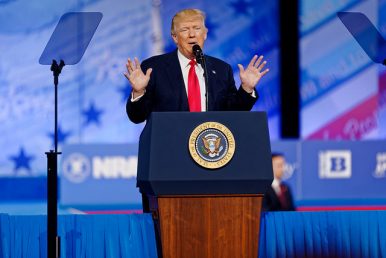By Mie Oba
 In January, Toshimitsu Motegi, the Japanese minister in charge of economic revitalization, announced that an agreement had been reached on TPP-11, absent the United States, and that it was set to be signed this March. Several days later, U.S. President Donald J. Trump attracted considerable attention for remarks hinting at the United States returning to the TPP. The evidence took the form of a speech delivered by Trump at the annual World Economic Forum in Davos, and an interview with U.S. media outlet CNBC he gave just before his speech.
In January, Toshimitsu Motegi, the Japanese minister in charge of economic revitalization, announced that an agreement had been reached on TPP-11, absent the United States, and that it was set to be signed this March. Several days later, U.S. President Donald J. Trump attracted considerable attention for remarks hinting at the United States returning to the TPP. The evidence took the form of a speech delivered by Trump at the annual World Economic Forum in Davos, and an interview with U.S. media outlet CNBC he gave just before his speech.
In fact, Trump made little mention of the TPP during his Davos speech. Most of the speech consisted of the president taking credit for job creation and economic revitalization that has taken place in the U.S. since he took office. Indeed, Trump emphasized his commitment to an “America First” policy that condemns “unfair trade” and pursues the U.S. national interest above all else. Trump simply mentioned the possibility of the U.S. pursuing negotiations with TPP members “either individually, or perhaps as a group.” During an earlier interview with CNBC, however, Trump noted that “we would do TPP if we made a much better deal than we had.” He also repeatedly described the TPP in its current form as “horrible.”
Consider the sum of these comments, and Trump is merely suggesting that the United States would be open to participating in a TPP whose provisions furthered the realization of the America First policy. This is not a “return to the TPP” by any measure; they are remarks that seek to jump on the bandwagon of the TPP-11 agreement while effectively calling for a renegotiation of its terms. Having led the TPP-11 negotiations, Japan probably made the right call in coolly describing the prospect of renegotiation as “practically impossible.”
Throughout its history of involvement in Asia, the United States has traditionally kept its distance from multilateral frameworks in the region as a matter of basic policy. While the Trump administration’s stance towards the TPP and other multilateral agreements is indeed extreme, in that sense it marks a shift back to America’s basic policy toward Asia. However, twice in the past the United States has taken a positive view of multilateral economic frameworks in Asia. The first was in the early to mid-1990s, which spanned the last stages of the Bush (senior) administration and a period of the Clinton administration, when the U.S. embraced an APEC-oriented policy. The second was from the closing days of the Bush (junior) administration through to the Obama administration, when the U.S. led negotiations to expand the TPP. In both cases, the U.S. stance was to emphasize a multilateral economic framework in Asia as a catalyst for revitalizing what were then slumping U.S. economies. Beyond these exceptions, however, an America First aspiration is hardly unique to the Trump administration.
Trump’s hinting at room for negotiation over a TPP he has said the U.S. will never return to suggests that even the president cannot ignore strong opposition from industrial and agricultural circles at home, which claim that the TPP withdrawal could impact them adversely. The U.S. midterms are approaching, and the need to shore up support for the administration from inside the country is likely a factor here. Increasing recognition that the TPP will be essential to further revitalizing the U.S. economy will be a necessary condition for America’s return to the trade pact.
Looking beyond the short-to-medium-term economic benefits the TPP will bring, in the long-term it is also important in terms of comprehensive rule setting for meaningful economic liberalization in the region, and showing that the countries involved share this approach to rule setting is in itself highly significant. In that context, the fact that a consensus was reached on the TPP-11 is significant. However the United States under the Trump administration acts, the member nations need to calmly move forward on initiatives to ensure the implementation of TPP-11.
Alongside the TPP, regional negotiations are also underway on another trade deal, the RCEP, or Regional Comprehensive Economic Partnership. The RCEP is an effort to form an economic bloc mainly comprising the existing ASEAN Economic Community with the addition of China and India. Progress made in TPP negotiations spurred on RCEP talks, which in turn further stimulated TPP efforts. It is thought that the recent consensus on TPP-11 has increased momentum for RCEP countries to reach a deal as well. If we consider the economic future of the Asia-Pacific region as a whole, the formation of an economic bloc that includes China and the establishment of standards for rule setting are both important, which makes it vital that RCEP negotiations move forward. Japan has taken a leadership position in both TPP-11 and RCEP negotiations, and has assumed a considerable role in the future development of the region.
Mie Oba is a Professor at the Tokyo University of Science.
No comments:
Post a Comment